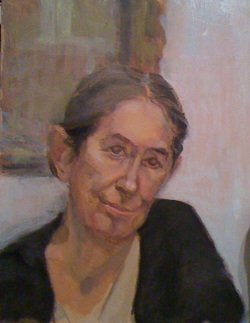The Wisdom of the Model: Amia's Story
A painted portrait results from the work that at least two people do together. The painter and the person being painted -- the model, the subject of the painting -- make the art. An understanding of what happens when a portrait is being created requires that we hear from both sides. Amia Lieblich, a friend and colleague, helps us understand. Last January, Amia and I worked together over several days to produce a number of drawings and a portrait sketch in oils. While I painted, she did a lot of observation and later recorded her notes. She then wrote a paper about the experience. The paper was delivered at a conference and is being published in the International Journal of Education and Art. Please click here to take a look at what she wrote. And click here to see a powerpoint presentation of photographs that accompanied her talk.
Amia Lieblich is Professor Emeritus of Psychology at the Hebrew University of Jerusalem, and she currently teaches in the Academic College of Tel Aviv-Jaffo. She is also now President of The Academic College for Social Sciences and the Arts, located in Netanya, Israel. Professor Leiblich is an internationally well-known figure in narrative psychology. Along with her foundational methodological and theoretical contributions to the field, such as her co-editorship of The Narrative Study of Lives series; she has written many well-received books about the psychology of Israeli society, such as Tin Soldiers on Jerusalem Beach, Kibbutz Makom and Seasons of Captivity. Her writings compellingly capture people as they live their lives. Note her work that focuses on the psychobiography of creative women. She has published books on Israeli writer Dvora Baron and poet Leah Goldberg. Her three most recent books are: Yaldei Kfar Etzion about the second generation of an Israeli kibbutz which was occupied and destroyed during the War of Independence, Arak for Breakfast, which describes a beach community of elderly citizens near Tel Aviv, and Watch Me – about her experience as a participant of a community theatre.
